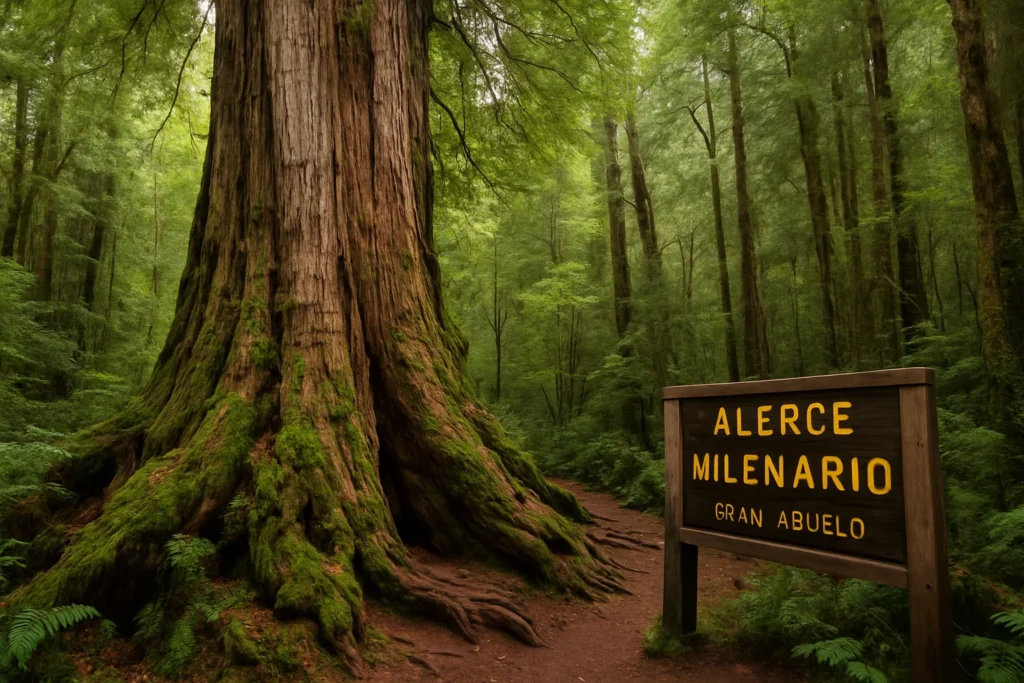Introduction: Whispers from a Bygone Era, A Tapestry of Time Unfurls
Imagine, if you can, a living being that has not just existed, but profoundly witnessed the relentless march of millennia, silently observing the grand spectacle of human civilization from its nascent beginnings to its bewildering complexities today. Deep within the enchanting, often mist-shrouded forests of southern Chile, a true titan stands tall. This magnificent figure, affectionately known as the Alerce Milenario – “The Millennial Alerce” – or, more intimately, the Great-Grandfather, is not merely a tree; it’s a profound, breathing archive of Earth’s deep past. This particular Patagonian cypress, scientifically designated Fitzroya cupressoides, has not only defied the ravages of time but has thrived through countless epochs, recently claiming the awe-inspiring title of the oldest living tree on Earth. Its astounding longevity now eclipses even the venerable bristlecone pines of California, creatures long thought to be the planet’s most ancient individual organisms.
Scientists, employing a delicate blend of cutting-edge technology and profound respect, have peered into the very heart of this ancient patriarch. Their meticulous estimations reveal that this arboreal marvel first unfurled its delicate, verdant leaves over 5,000 years ago. To truly grasp the immensity of this timeframe, consider this: this tree was a mere sapling, a tender sprout reaching for the sun, when humanity in ancient Egypt was meticulously stacking colossal stones to form the first monumental pyramids. Its awe-inspiring, almost unbelievable existence compels us to radically rethink the very limits of longevity in the natural world and, more urgently, underscores the paramount importance of safeguarding these living monuments—these irreplaceable treasures of our planet’s natural heritage. They are not just botanical curiosities; they are vital, irreplaceable threads in the grand tapestry of life.
The Discovery: Unraveling the Great-Grandfather’s Timeline with Scientific Ingenuity
For decades, the undisputed monarch of the arboreal world was Methuselah, a remarkably resilient bristlecone pine nestled in the White Mountains of California, boasting an impressive and long-revered age of 4,850 years. Its reign as the world’s oldest tree was seemingly unassailable, a testament to its hardy survival in extreme conditions. Yet, the quiet, long-held reign of Methuselah was dramatically challenged in 2022 by a groundbreaking announcement that reverberated with excitement and anticipation throughout the international scientific community. This pivotal moment came from Chilean environmental scientist Jonathan Barichivich and his dedicated team of researchers. Their meticulous and innovative investigations revealed a truth that was both astonishing and humbling: the Great-Grandfather was, by all scientific indications, even older, a living fossil surpassing all previous records.
Dating a tree that has graced the Earth for five millennia is an intricate process, far removed from the simple act of counting rings on a freshly cut stump. The sheer, colossal scale of the Alerce Milenario, with a trunk diameter exceeding a staggering 13 feet, presented a unique and formidable challenge. The traditional method of dendrochronology, which involves extracting a full core sample spanning the entire radius of the tree, was deemed too risky. Such an invasive procedure, they concluded, could cause irreparable harm to this precious, living relic. So, Barichivich and his team pioneered an innovative, non-invasive approach, meticulously weaving together several scientific threads to construct the tree’s remarkable timeline without causing it distress. They began by carefully analyzing partial core samples, taking only a small, unobtrusive segment of the tree’s outer growth. This precious data was then meticulously compared with the growth patterns observed in younger, more accessible Alerce trees through sophisticated growth rate modeling. This allowed them to extrapolate the elder’s growth trajectory backward through millennia, much like piecing together a vast, ancient puzzle. Crucially, they integrated vast amounts of climate data, understanding precisely how historical weather patterns, shifts in temperature, and environmental changes influenced its annual growth rings. Each ring, a silent testament to a year gone by, held clues about droughts, wet periods, and even volcanic eruptions. The culmination of this intricate scientific detective work, blending observational data with statistical rigor, yielded a stunning and highly probable statistical estimate of 5,484 years. This calculation was accompanied by a robust 80% confidence level, indicating that its age definitively surpasses 5,000 years, solidifying its claim as the planet’s most ancient individual tree.
A Witness to Epochs: What Makes This Tree Truly Extraordinary? A Living Chronicle of Earth and Humanity
The Great-Grandfather is not merely an impressive botanical specimen; it’s a sentient entity, a living chronicle, a silent and unwavering observer that has watched the world transform around it in ways we can barely comprehend. Its very existence forces us to confront the profound concept of deep time.
1. A Living History Book of Human Civilization: From Stone Tools to Smartphones
Imagine, for a breathtaking moment, the sweeping, epic panorama of human history that has unfolded beneath its ancient, gnarled branches. This tree was already a young, vigorous individual when Stone Age hunters roamed the vast, untamed landscapes that would one day become modern Chile, their lives dictated by the rhythm of the seasons and the hunt. It stood stoically, a silent giant, as the first great civilizations — the sophisticated societies of Egypt along the Nile, the fertile crescent’s Mesopotamia, the enigmatic Indus Valley civilization – rose from nascent settlements. It witnessed the ingenious minds of early humans build monumental structures, develop intricate systems of governance, codify laws, and forge complex belief systems. It then saw the rise and fall of mighty empires, from the martial might of Rome to the intricate artistry of the Mayans in distant lands, observing their triumphs, their periods of glory, and their eventual, inevitable decline. It endured the gradual evolution of human knowledge, from the first rudimentary tools to the transformative power of the Industrial Revolution, which reshaped landscapes and societies, and on to the dizzying, exponential pace of modern technology, including the very devices through which we now share its story. Yet, through all this unprecedented human dynamism and change, this tree has remained a steadfast, unmoving sentinel, growing slowly, almost imperceptibly, in the serene heart of Chile’s temperate rainforests. Its concentric rings hold not just the secrets of ancient climates, but the very echoes of forgotten human endeavors, the silent testament of countless sunrises and sunsets it has absorbed.
2. A Testament to Survival Against Unimaginable Odds: Enduring the Fury of Time
The path to achieving an astonishing 5,000 years of life is not a tranquil stroll; it is fraught with unimaginable perils and cataclysms. The Alerce Milenario has defied countless threats that would have easily felled lesser, younger beings, demonstrating a profound biological resilience that continues to baffle scientists. Its remarkably thick, deeply furrowed, and highly fire-resistant bark has provided an impenetrable shield, protecting it from the ravages of wildfires that have swept through these forests with destructive fury across millennia, leaving only charred remnants in their wake. It has stoically endured dramatic and profound climate shifts, from the frigid, grinding grip of ancient ice ages that scoured continents to the more recent, rapid warming trends of the modern era, adapting its growth to each climatic twist. Perhaps its most significant, and certainly its most recent, challenge has been the relentless, often brutal human threat. The insatiable demand for timber nearly pushed its entire species, the majestic Alerce, to the very brink of extinction, its ancient forests decimated by chainsaws and axes. Yet, through it all – through fire, ice, and human greed – this ancient giant has persisted, a living, breathing testament to the almost incomprehensible resilience and adaptive power of nature.
3. A Scientific Treasure Trove: Unlocking Earth’s Past and Future
Beyond its simply awe-inspiring age, the Great-Grandfather represents an invaluable and utterly irreplaceable scientific goldmine. It’s a natural laboratory, a data repository of unparalleled depth. By meticulously studying its concentric growth rings, scientists can unlock an unprecedented archive of ancient climate patterns, effectively reconstructing millennia of precise data on rainfall, temperature fluctuations, atmospheric composition, and even volcanic activity. Each ring is a tiny, perfect time capsule. This data is absolutely crucial for understanding long-term climate variability, offering critical context for current climate change. It also provides profound insights into forest resilience, helping researchers decipher the complex biological and ecological mechanisms that allow certain species to achieve such extraordinary longevity. How do they resist disease? What genetic traits contribute to their endurance? Moreover, these ancient behemoths are not just passive observers; they are active, vital participants in our planet’s health. As champions of carbon sequestration, they store massive amounts of carbon dioxide within their vast trunks, roots, and branches, effectively acting as gargantuan carbon sinks. This makes them crucial allies in the ongoing global fight against climate change, playing a vital role in regulating the planet’s atmospheric balance.
The Quiet Debate: Protecting a Sacred Secret, Balancing Access and Preservation
While Jonathan Barichivich’s groundbreaking methodology and statistical models are widely respected within the scientific community for their rigor and innovation, a quiet, scholarly debate persists. Some scientists, adhering to the strictest, most traditional interpretation of dendrochronology, argue that without a full ring count (which, as discussed, is impossible without harming the tree), the tree’s exact age cannot be definitively declared. However, even their most conservative estimates, based on the partial data available, still place its age well beyond 4,000 years, firmly securing its place among the oldest individual organisms on Earth. The question is not if it’s incredibly old, but precisely how old.
Yet, a more significant, and ethically complex, debate revolves around a poignant and deeply felt question: Should the Great-Grandfather’s precise geographical location remain a closely guarded secret? This is a dilemma that pits scientific openness against conservation imperatives. Advocates for secrecy argue passionately that publicizing its exact whereabouts would almost inevitably lead to an uncontrolled influx of tourists and curious visitors. Such an increase in human presence, they fear, could cause irreparable vandalism and severe environmental degradation from increased foot traffic, soil compaction around its delicate root system, and general human activity. The sheer volume of love, however well-intentioned, could literally kill it. On the other hand, those who believe its location should be more broadly shared contend that revealing its existence and whereabouts would foster far greater public awareness and bolster broader conservation efforts, rallying vital support for its protection by making it a tangible symbol. For now, a handful of trusted researchers and park officials hold the precious knowledge of its exact coordinates, a delicate and continuously re-evaluated balance between the pursuit of scientific understanding and the profound responsibility of preservation. This is a burden they carry with immense care.
Guardians of Giants: The Imperative to Protect Ancient Trees for Future Generations
The Alerce Milenario stands as a powerful and deeply moving emblem of nature’s boundless endurance, a testament to life’s tenacity against all odds. But it also serves as a stark, chilling reminder of the profound vulnerability of these irreplaceable ancient ecosystems in the face of modern, often relentless, human challenges. Its continued existence is a fragile miracle.
Threats Looming Over the Great-Grandfather: The Scars of Progress
Even this ancient titan, a living bridge to a primordial past, is not immune to the pressures of a rapidly changing world. Climate change, with its increasingly unpredictable weather patterns, bringing with it prolonged periods of drought and rising temperatures, places immense physiological stress on these already ancient trees, making them more susceptible to disease and decline. Deforestation continues to decimate Chile’s precious Alerce forests with alarming speed; these magnificent woodlands, once vast, have tragically shrunk by an estimated 40% in recent centuries due to illegal logging and agricultural expansion. Furthermore, the growing allure of tourism pressure, while often born of genuine admiration and curiosity, can inadvertently cause severe harm to the tree by compacting the soil around its sensitive root system, disrupting its delicate nutrient uptake, and altering its immediate ecosystem. The very love for the tree can ironically become its greatest threat.
Current Conservation Efforts and the Path Forward: A Collective Responsibility
Recognizing its immense, incalculable value, the Chilean government has taken a crucial first step by declaring the Alerce a National Monument, bestowing upon it a degree of legal protection. However, environmental activists, passionate conservationists, and concerned scientists are vociferously advocating for even stronger, more comprehensive protections. This includes the urgent implementation of stricter anti-logging laws to prevent any further decimation of its ancient kin and remaining forests. They also champion the expansion of national parks and protected areas, creating broader, undisturbed sanctuaries where these ancient ecosystems can thrive without human encroachment. Crucially, they call for the establishment of controlled scientific access, ensuring that vital research can continue while minimizing human impact and allowing this irreplaceable wonder to live out its millennia in peace. It’s a collective responsibility that transcends borders and generations.
Lessons from a 5,000-Year-Old Teacher: Wisdom Etched in Wood
The Great-Grandfather offers profound, unspoken lessons, wisdom whispered through its ancient, deeply furrowed bark and gnarled, weathered branches. It is a living mentor, if we are willing to listen:
- Resilience: It teaches us about the extraordinary, almost unfathomable capacity for survival, enduring millennia of relentless geological, climatic, and biological change and adversity. Its very presence is a beacon of enduring strength.
- Patience: Its slow, steady, almost imperceptible growth, sometimes just a millimeter per year in certain centuries, serves as a powerful reminder of the power of gradual, persistent progress. Not everything needs to be fast; true enduring strength often comes from slow, deliberate growth.
- Interconnectedness: Like all ancient trees, it underscores the intricate, delicate web of life. These majestic elders are not solitary figures; they are keystone species, supporting entire ecosystems and providing shelter, sustenance, and vital biological services for countless species, from microscopic fungi to soaring eagles.
As Jonathan Barichivich, the scientist who brought its age to light, eloquently and passionately puts it: “This isn’t just a tree—it’s a time capsule. Protecting it means preserving a living piece of Earth’s history.” It’s a legacy we are entrusted to safeguard.
Conclusion: A Call to Action for Earth’s Elders, A Promise for the Future
The revelation of the Alerce Milenario’s astonishing age is far more than a mere scientific curiosity; it fundamentally compels us to reshape our understanding of life’s incredible tenacity and endurance on Earth. If a single, silent tree can stand strong, can live for 5,000 years, weathering every storm and change, what does that profound longevity imply about our own fleeting existence and, more critically, our often-disruptive impact on the very planet that cradles and sustains us? It forces a moment of quiet introspection.
As humanity grapples with the escalating, multifaceted crises of climate change, the alarming rate of biodiversity loss, and the relentless degradation of natural habitats, this ancient giant stands as a silent, majestic guardian. It is a living, breathing testament to what is possible when nature is left undisturbed, and a stark, urgent reminder that some things—particularly the irreplaceable, venerable elders of our natural world—are not just worth protecting for today, or for the next generation, but for the next 5,000 years and beyond. Its very existence is not just a wonder; it is a profound and pressing call to action, urging us to become better, more conscious stewards of this precious planet and its awe-inspiring living wonders.
Do you believe humanity has a moral obligation to protect these ancient natural wonders, even if it means limiting access to them? What other measures do you think could help preserve Earth’s oldest trees?




k9c5ku